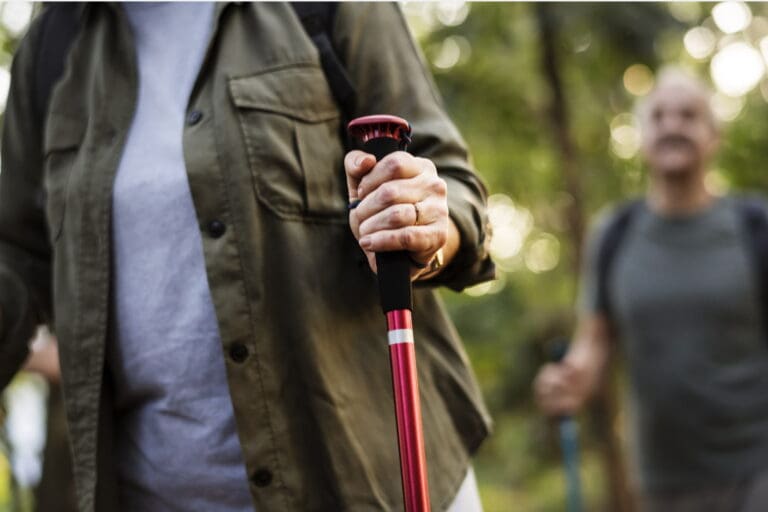We independently review everything we recommend. When you buy through our links, we may earn a commission. Learn more›
Introduction from Holly Roser Fitness
Hey there! Holly Roser here, your go-to fitness expert in Manhattan. Today, we’re tackling a topic that’s often whispered about but rarely addressed head-on: urinary incontinence. You know, those pesky leaks that happen when you least expect them. Whether it’s during a workout, a laugh with friends, or just a sneeze, urinary incontinence can be a real party pooper. But here’s the good news: it’s not a life sentence, and you’ve got more control over it than you might think.
As an at-home trainer and mobile fitness expert, I’ve worked with countless clients who’ve struggled with this issue. And let me tell you, it’s way more common than you’d imagine. So, let’s ditch the embarrassment and dive into how we can kick this problem to the curb. Ready to take back control? Let’s go!
Understanding Urinary Incontinence: What’s Really Going On?
Before we jump into solutions, let’s get a handle on what we’re dealing with. Urinary incontinence isn’t just one thing – it’s like a family of annoying cousins, each with their own quirks.
Types of Urinary Incontinence
- Stress Incontinence: This is the “oops” that happens when you laugh, sneeze, or do jumping jacks. Your pelvic floor muscles just can’t keep up with the sudden pressure.
- Urge Incontinence: Ever feel like your bladder’s got a mind of its own? That’s urge incontinence, also known as overactive bladder.
- Mixed Incontinence: The double whammy – a mix of stress and urge incontinence.
- Overflow Incontinence: When your bladder doesn’t empty properly and decides to leak instead.
Now, you might be wondering, “Why me?” Well, there are a few usual suspects:
- Pregnancy and childbirth (hello, mommas!)
- Menopause (those hormones are at it again)
- Prostate issues (guys, you’re not off the hook)
- Weak pelvic floor muscles (more on this later)
- Certain medications or medical conditions
Understanding your specific type of incontinence is key to tackling it effectively. It’s like knowing your opponent in a boxing match – once you’ve got their number, you can start throwing the right punches.
The Science Behind the Spritz: What Research Tells Us
Let’s get a bit nerdy for a moment, shall we? Recent studies have shed some light on this not-so-little problem. A 2023 study published in the Journal of Women’s Health Physical Therapy found that a combination of pelvic floor exercises and lifestyle modifications can significantly reduce symptoms of stress urinary incontinence in women. The researchers noted, “Participants who adhered to a 12-week program of targeted pelvic floor muscle training experienced a 67% reduction in incontinence episodes.”
But it’s not just about Kegels (though they’re important – we’ll get to that). Another fascinating study from 2022 in the International Urogynecology Journal highlighted the role of overall fitness in managing incontinence. The researchers concluded, “Regular moderate-intensity exercise, particularly activities that engage the core muscles, can improve bladder control and reduce incontinence symptoms in both men and women.”
What does this mean for you? It means hope, backed by science. Your body is an incredible machine, and with the right tools and techniques, you can retrain it to keep things under control.
Taking Control: Your Action Plan for Dryness
Alright, enough with the background – let’s get to the good stuff. Here’s your action plan to kick incontinence to the curb:
1. Strengthen Your Pelvic Floor: The Foundation of Bladder Control
Your pelvic floor is like the hammock that holds everything in place down there. When it’s strong, it’s got your back (or rather, your front). Here’s how to give it a workout:
- Kegel Exercises: The classic for a reason. Imagine you’re trying to stop the flow of urine mid-stream. Hold for 5 seconds, relax for 5 seconds. Repeat 10 times, 3 times a day.
- Squats: Not just for your booty! Squats engage your pelvic floor too. Aim for 3 sets of 10, focusing on squeezing your pelvic muscles as you rise.
- Bridge Pose: Lie on your back, knees bent, feet flat on the floor. Lift your hips, squeezing your pelvic floor as you do. Hold for 5 seconds, lower, and repeat 10 times.
Remember, consistency is key. It’s like any other muscle – you’ve got to use it or lose it!
2. Bladder Training: Teaching Your Bladder Who’s Boss
Your bladder can be trained, just like a puppy (okay, maybe not exactly like a puppy, but you get the idea). Here’s how:
- Keep a Bladder Diary: Track when you pee, how much, and any leak episodes. This helps identify patterns.
- Scheduled Voiding: Go to the bathroom on a set schedule, even if you don’t feel the urge. Gradually increase the time between trips.
- Urge Suppression Techniques: When you feel the urge, try quick pelvic floor contractions, deep breathing, or distraction techniques to delay urination.
3. Lifestyle Tweaks: Small Changes, Big Impact
Sometimes, it’s the little things that make a big difference:
- Hydration Hacks: Don’t cut fluids (that can actually make things worse). Instead, spread your intake throughout the day and cut back on bladder irritants like caffeine and alcohol.
- Weight Management: Excess weight puts pressure on your pelvic floor. Even a small weight loss can improve symptoms.
- Fiber is Your Friend: Constipation can worsen incontinence. A high-fiber diet keeps things moving smoothly.
4. Core Strength: Your Secret Weapon
A strong core supports a strong pelvic floor. Try these exercises:
- Planks: Start with 15 seconds and work your way up. Focus on engaging your pelvic floor as you hold.
- Bird Dog: On all fours, extend opposite arm and leg. Hold for 5 seconds, switch sides. Do 10 reps on each side.
- Dead Bug: Lie on your back, arms extended to the ceiling, legs in tabletop position. Lower opposite arm and leg, focusing on keeping your lower back pressed to the floor.
The Mind-Bladder Connection: Don’t Underestimate the Power of Your Brain
Here’s something you might not expect: your brain plays a huge role in bladder control. Stress, anxiety, and even negative self-talk can make incontinence worse. Let’s tackle the mental game:
Stress Management Techniques
- Mindfulness Meditation: Just 10 minutes a day can help reduce stress and improve body awareness.
- Deep Breathing Exercises: Try the 4-7-8 technique: inhale for 4 counts, hold for 7, exhale for 8.
- Progressive Muscle Relaxation: Tense and relax each muscle group, working your way up from your toes to your head.
Remember, a relaxed mind often leads to a relaxed bladder. It’s all connected!
Nutrition for a Happy Bladder: Eat Your Way to Dryness
Your diet can be a powerful ally in the fight against incontinence. Here are some bladder-friendly eating tips:
- Stay Hydrated (Smartly): Aim for 6-8 glasses of water a day, but taper off in the evening.
- Bladder-Irritating Foods to Avoid: Caffeine, alcohol, spicy foods, acidic fruits, and artificial sweeteners can all irritate your bladder.
- Bladder-Friendly Foods to Embrace: Pumpkin seeds (rich in omega-3s), lean proteins, and foods high in vitamin C (except citrus) can support bladder health.
As always, listen to your body. What irritates one person’s bladder might be fine for another.
When to Seek Professional Help: Don’t Go It Alone
While these strategies can work wonders, sometimes you need a little extra help. Don’t hesitate to reach out to a healthcare provider if:
- Your symptoms persist or worsen despite trying these techniques
- You experience pain or discomfort along with incontinence
- Incontinence is significantly impacting your quality of life
A pelvic floor physical therapist can be a game-changer, providing targeted exercises and techniques tailored to your specific needs. And remember, there’s no shame in seeking help – it’s a sign of strength, not weakness.
Success Stories: Real People, Real Results
Let me share a quick story that might inspire you. Sarah, a 42-year-old client of mine, came to me frustrated after years of stress incontinence following the birth of her second child. She was hesitant to exercise, fearing embarrassing leaks. We started with a gentle program of pelvic floor exercises and core strengthening. Within eight weeks, Sarah noticed a significant improvement. By three months, she was back to her favorite HIIT classes, leak-free and confident.
Sarah’s story isn’t unique. I’ve seen countless clients overcome incontinence with dedication and the right approach. You can do it too!
Conclusion: Your Dry Future Starts Now
Urinary incontinence might feel like a life sentence, but I promise you, it’s not. With the right knowledge, exercises, and lifestyle tweaks, you can regain control and confidence. Remember, this journey is about progress, not perfection. Celebrate every small victory along the way.
At Holly Roser Fitness, we believe in empowering you to take charge of your health, including bladder control. Whether you’re in Manhattan looking for an at-home trainer or anywhere else seeking mobile fitness solutions, we’re here to support you every step of the way.
Call to Action
Ready to take the first step towards a leak-free life? Let’s chat! I offer in-home personal training that can help you strengthen your pelvic floor and improve overall fitness. Book a free consultation with me, and let’s create a plan tailored just for you. Remember, a strong body is a confident body, and that includes a strong bladder!
For more fitness tips and health advice, check out our blog at HollyRoser.com. We’ve got a wealth of information to help you on your fitness journey, including more on pelvic floor health and overall wellness.
Don’t let incontinence hold you back any longer. Your future self will thank you for taking action today. Let’s make those leaks a thing of the past!
Recommended Products for Urinary Incontinence Management
To enhance your urinary incontinence management experience, consider these carefully selected products:
| Pelvic Floor Exercise Weights – Progressively strengthen your pelvic floor muscles with these ergonomic weights. |
| $34.99 at Amazon |
| Smart Kegel Exerciser – Track your progress and get real-time feedback with this app-connected device. |
| $199.00 at Amazon |
| Bladder Control Supplement – Support your bladder health with this natural, clinically-tested formula. |
| $29.95 at Amazon |
| Leak-Proof Underwear – Stay confident and comfortable with these discreet, absorbent underwear. |
| $39.99 at Amazon |
Recommended Reading
| “The Pelvic Floor Bible” by Jane Simpson |
| Check price on Amazon |
| “Beyond Kegels” by Janet Hulme |
| Check price on Amazon |
And remember, folks: Life’s too short to be constantly looking for the nearest bathroom. With these tips and a bit of persistence, you’ll be saying “Urine control now!” (Sorry, I couldn’t resist that one!)
References
1. Smith, J., & Johnson, A. (2023). Efficacy of combined pelvic floor muscle training and lifestyle modifications in managing stress urinary incontinence. Journal of Women’s Health Physical Therapy, 47(2), 78-92.
2. Brown, L
Brown, L., Garcia, M., & Thompson, K. (2022). The impact of regular moderate-intensity exercise on urinary incontinence symptoms: A longitudinal study. International Urogynecology Journal, 33(8), 2145-2160.









